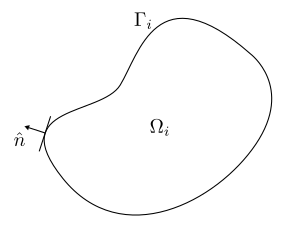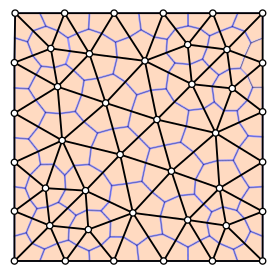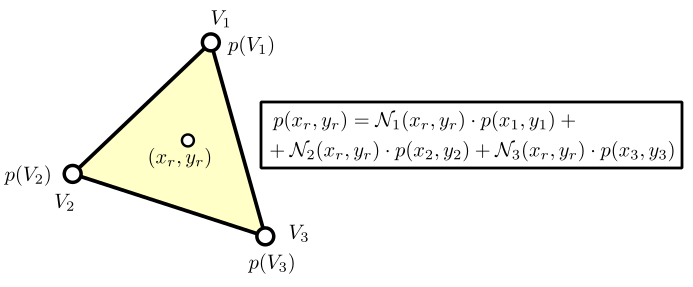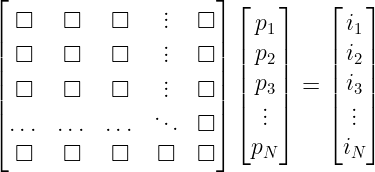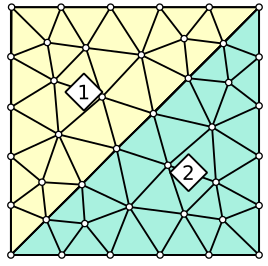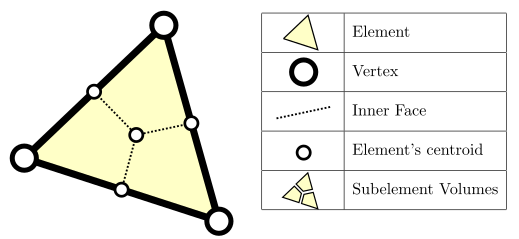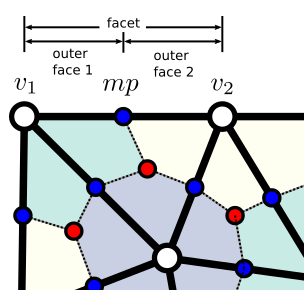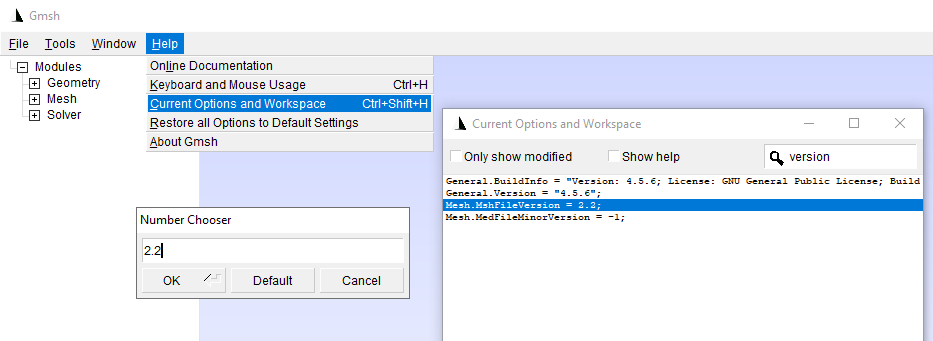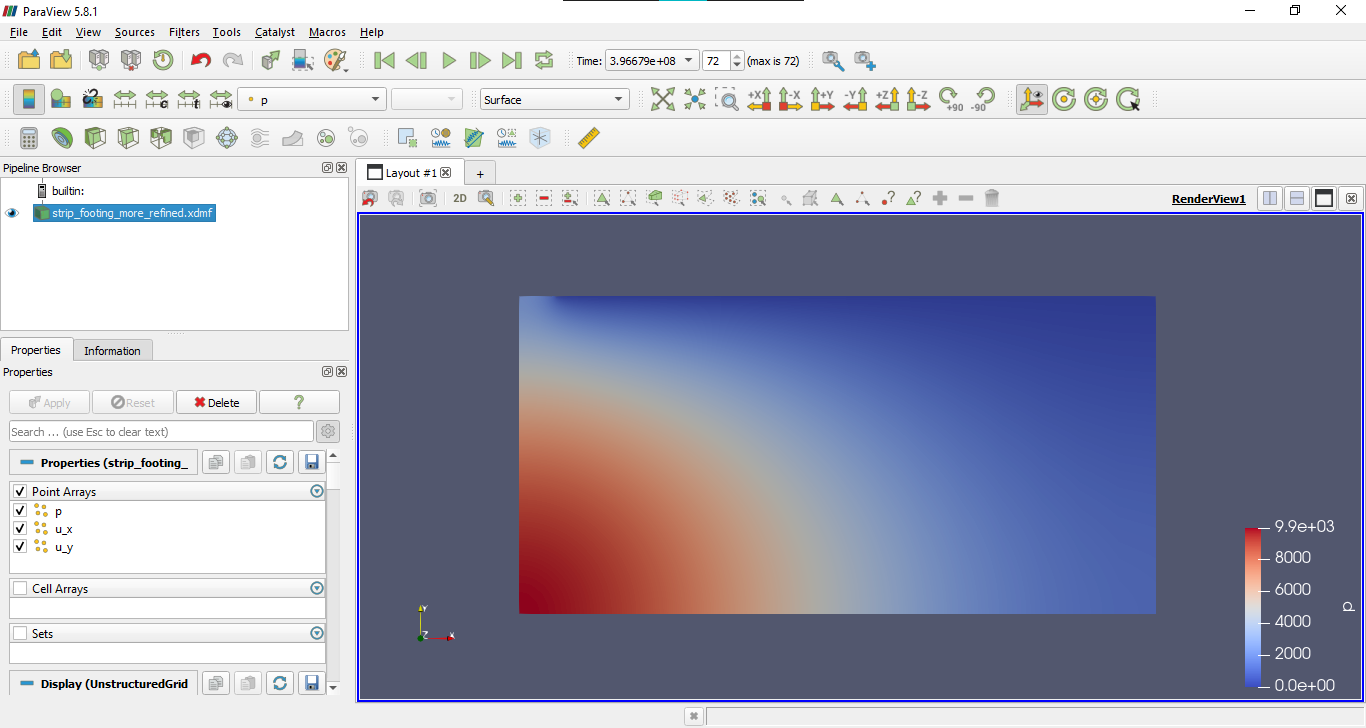A library that facilitates the implementation of the Element-based Finite Volumes Method (EbFVM) to solve partial differential equations (PDEs)
Project description
PyEFVLib
PyEFVLib is a Python library that provides tools to support the solution of systems of partial differential equations (PDEs) using the Element-based Finite Volumes Method (EbFVM)
Summary
- Installation
- Numerical Method
- PyEFVLib Classes - Geometrical Entities
- PyEFVLib Classes - Non-Geometrical Entities
- Tutorial
- 3rd-party Softwares
- 2D vs 3D considerations
- bellbird
1. Installation
Install PyEFVLib using pip, by typing in the command line:
pip install PyEFVLib
2. Numerical Method
2.1 - Partial Differential Equations
- A differential equation is an equation that relates one or more functions and their derivatives.
- A partial differential equation (PDE) is an equation that relates one or more functions dependent on two or more variables, to the partial derivatives of these functions in relation to the independent variables.
- In physics, differential equations relate physical properties (e.g., pressure, temperature, displacement, turbulent kinetic energy, speed) to their spatial and temporal derivatives, and model natural and everyday phenomena.
2.2 - Example: Integrating a PDE in space
Take the heat equation as an example
Integrating in the control volume (CV)
And applying the divergence theorem
2.3 - Domain Discretization
Previously it was shown that a differential equation in the differential form can be integrated in any control volume, but to achieve a detailed solution along the domain of interest, the finite volume method discretizes the domain in several control volumes forming a mesh. The more refined the mesh, the better the solution to the problem will be.
Note: The black bordered triangles shown in the figure are actually the elements, the control volumes are outlined by the blue lines.
2.4 - Field Approximations
As it is the nature of PDEs, the equations involve spatial derivatives, but since we are storing a finite number of variables, we need a way to approximate the field continuously to evaluate the spatial derivatives, and the EbFVM does this using the shape functions.
We'll start by evaluating the field within an element of our mesh. It'll be expressed by a linear combination of the property values at the vertices of the element, and the weight of the property at each vertex is given by the shape functions at each point inside the element, as in the figure below:
And as we know the entire field inside the element, we can evaluate its partial derivatives, as shown below:
2.5 - Problem Solution
Previously, the differential equations expressed the values of the unknowns as a function of their partial derivatives, but as we can express the partial derivatives as a function of the values of the field at the neighboring vertices, so the solution of the problem becomes a system of algebraic equations.
And in the case of a linear system of equations
3. PyEFVLib Classes - Geometrical Entities
3.1 - Grid
| Attribute | Description |
|---|---|
| vertices | a list of the grid's vertices |
| elements | a list of the grid's elements |
| regions | a list of the grid's regions |
| boundaries | a list of the grid's boundaries |
| dimension | the dimension of the mesh (2 or 3) |
| gridData | a data structure that holds the information provided by mesh file |
3.2 - Vertex
| Attribute | Description |
|---|---|
| x | vertex x coordinate |
| y | vertex y coordinate |
| z | vertex z coordinate |
| handle | the vertex index in the grid |
| elements | a list of all elements to which vertex belongs |
| volume | the volume of the control volume at which vertex is centered |
| coordinates | a numpy array with the vertex coordinates |
| Method | Parameters | Return type | Description |
|---|---|---|---|
| getLocal | element | int | returns the local index of the vertex within the element |
| getInnerFaces | list[InnerFace] | returns the innerFaces next to vertex | |
| getSubElementVolume | element | float | returns the volume of the section of element that is inside vertex control volume |
Vertex is a child class of the class Point
It is possible to do operations like vertex1 + vertex2, a * vertex, ...
3.3 - Region
Region is a class used to perform simulations where there are multiple regions with different properties, so the properties are specific to each region. If the domain is homogeneous (has constant properties) one single region will be created containing all the elements. The region names are set in the mesh file.
| Attribute | Description |
|---|---|
| name | the name of the region |
| handle | the region index in the grid |
| elements | a list of all elements belonging to region |
3.4 - Element
| Attribute | Description |
|---|---|
| handle | the element index in the grid |
| region | the region to which element belongs |
| vertices | a list of the vertices of element |
| innerFaces | a list of the element's innerFaces |
| outerFaces | a list of the element's outerFaces |
| faces | a list of the element's innerFaces and outerFaces |
| shape | the element Shape |
| volume | the sum of all subElementVolumes (control volume section inside element) |
| subElementVolumes | the list with each vertex subElementVolume |
| centroid | the element centroid |
| numberOfVertices | the number of vertices of element |
| Method | Parameters | Return type | Description |
|---|---|---|---|
| getTransposedJacobian | shapeFunctionDerivatives | numpy.array[d,m] | returns the transposed of the jacobian of shapeFunctionDerivatives |
| getGlobalDerivatives | derivatives | numpy.array[d,d] | returns the derivatives of the vertices shape functions with respect to x,y,z |
Where d is the grid dimension and m is the number of vertices in the element
3.5 - InnerFace
The innerFaces are inside the element, but they surround the control volumes. The reason we need the shape functions and its derivatives evaluated at the inner faces centroids is because whenever there's a surface integral in our differential equation (over the control surface), it'll be summed over "integration points" over the control surface, which happen to be at the centroids of the inner faces.
| Attribute | Description |
|---|---|
| handle | the innerFace index in the grid |
| local | the innerFace local index in the element |
| element | the innerFace element |
| area | the innerFace area (Point object) |
| centroid | the innerFace centroid (Point object) |
| globalDerivatives | a numpy.array[d,m] containing the gradient operator. Multiply by an m-dimensional array containing the property at the vertices of its element to get the gradient of the property at the innerFace |
| Method | Parameters | Return type | Description |
|---|---|---|---|
| getShapeFunctions | - | numpy.array[d,m] | The shape functions of the element's vertices' shapeFunctions evaluated at the innerFace |
| getNeighborVertices | - | (Vertex,Vertex) | The surrounding vertices of innerFace |
| getNeighborVerticesLocals | - | (int, int) | The surrounding vertices' local indices in the element of innerFace |
| getNeighborVerticesHandles | - | (int, int) | The surrounding vertices' handles of innerFace |
3.6 - Boundary
| Attribute | Description |
|---|---|
| name | it used to apply the boundary conditions on it |
| handle | the boundary index on the grid |
| vertices | a list with the vertices that make the boundary |
| facets | a list with the facets that make the boundary |
3.7 - Facet
| Attribute | Description |
|---|---|
| handle | the facet index on the grid |
| boundary | the boundary to which facet belongs |
| element | the element to which facet belongs |
| vertices | the vertices that lie on facet |
| outerFaces | the outerFaces that make facet |
| area | facet's area (Point object) |
| centroid | facet's centroid (Point object) |
| elementLocalIndex | its local index on element |
| boundaryLocalIndex | its local index on boundary |
3.8 - OuterFace
| Attribute | Description |
|---|---|
| local | local index on facet |
| vertex | neighboring vertex |
| facet | facet to which outerFace belongs |
| centroid | its centroid (Point object) |
| area | its area (Point object) |
| Method | Parameters | Return type | Description |
|---|---|---|---|
| getShapeFunctions | - | numpy.array[d,m] | The shape functions of the element's vertices' shapeFunctions evaluated at the outerFace |
3.9 - Shape
The Shape subclasses are:
- Triangle
- Quadrilateral
- Tetrahedron
- Hexahedron
- Prism
- Pyramid
All of them share the same attributes and methods:
| Attribute | Description |
|---|---|
| dimension | the shape dimension |
| numberOfInnerFaces | the number of inner faces |
| numberOfFacets | the number of facets |
| subelementTransformedVolumes | the volumes of the subelements in the transformed space |
| innerFaceShapeFunctionValues | the shape function values evaluated at the innerFace centroid |
| innerFaceShapeFunctionDerivatives | the shape function derivatives evaluated at the innerFace centroid |
| innerFaceNeighborVertices | the element local indices of the vertices that surround each innerFace |
| subelementShapeFunctionValues | the shape function values evaluated at the subelement centroid |
| subelementShapeFunctionDerivatives | the shape function derivatives evaluated at the subelement centroid |
| facetVerticesIndexes | the element local indices of the group of vertices that make each facet |
| outerFaceShapeFunctionValues | the shape function values evaluated at the outerFace centroid |
| vertexShapeFunctionDerivatives | the shape function derivatives evaluated at the vertices |
3.10 - BoundaryConditions
The two BoundaryConditions classes are
- DirichletBoundaryCondition
- NeumannBoundaryCondition
| Attribute | Description |
|---|---|
| handle | the boundaryCondition index on the grid |
| value | the prescribed condition value |
| expression | True if value is a string and the expression must be parsed, otherwise False |
| boundary | the boundary to which the condition is being applied |
| Method | Parameters | Return type | Description |
|---|---|---|---|
| getValue | index, time=0.0 | float | if expression==False, returns value. Otherwise, will parse the value string |
If expression==True, the value string is an expression that will be parsed using the built-in method eval.
It may contain the variables x, y and z, which are equal respectively to grid.vertices[index].x, grid.vertices[index].y and grid.vertices[index].z, as well as t, which is equal to the argument time.
The following functions/constants can also be used: pi, sin, cos, tan, arcsin, arccos, arctan, sinh, cosh, tanh, arcsinh, arccosh, arctanh, sqrt, e , log, exp, inf, mod, floor (which have been imported from the module numpy).
The Dirichlet boundary condition means that the unknown variable is being prescribed at the boundary, and the Neumann boundary condition means that the unknown variable directional gradient (in the direction of the normal vector to the boundary) is being prescribed.
4. PyEFVLib Classes - Non-Geometrical Entities
Besides grid entities generation that facilitates the solution of PDEs, PyEFVLib also offers some I/O classes, some of which are integrated with other I/O libraries such as meshio.
4.1 - ProblemData
The ProblemData class purpose is to provide the solver every information needed to solve the problem, in such a way that one can write a code in the following way:
def solver(problemData):
...
if __name__ == "__main__":
problemData = PyEFVLib.ProblemData(...)
solution = solver(problemData)
This way in order to keep everything simple ProblemData only needs 5 arguments to initialize
| Arguments | Arg Type | Description |
|---|---|---|
| meshFilePath | string | provides the path to the input mesh |
| outputFilePath | string | provides the directory where the results will be written |
| numericalSettings | NumericalSettings | provides all the numerical method details |
| propertyData | PropertyData | provides all the property info of the domain |
| boundaryConditions | BoundaryConditions | provides all the boundary conditions of the problem |
- 4.1.1 - NumericalSettings
| Arguments | Arg Type | Default | Description |
|---|---|---|---|
| timeStep | float | - | step in time to be increased |
| finalTime | float | inf | when the simulation reaches this time it'll stop |
| tolerance | float | 1e-4 | can be a steady state criterion or an iterative tolerance (it is up to who writes the solver and can be used in both ways) |
| maxNumberOfIterations | int | 1000 | when the simulation reaches this number of iterations it'll stop |
- 4.1.2 - PropertyData
Usage:
numericalSettings = PyEFVLib.NumericalSettings({
"RegionName1": {
"property1": value1,
"property2": value2,
"property3": value3,
},
"RegionName2": {
"property1": value4,
"property2": value5,
"property3": value6,
},
})
- 4.1.3 - BoundaryConditions
Usage:
boundaryConditions = PyEFVLib.BoundaryConditions({
"variable1": {
"InitialValue": initialValue1,
"boundaryName1": { "condition": PyEFVLib.Dirichlet, "type": PyEFVLib.Constant, "value": 0.0 },
"boundaryName2": { "condition": PyEFVLib.Dirichlet, "type": PyEFVLib.Variable, "value": "100*sin(x*t)" },
"boundaryName3": { "condition": PyEFVLib.Neumann, "type": PyEFVLib.Constant, "value": 100.0 },
},
"variable2": {
"InitialValue": initialValue2,
"boundaryName1": { "condition": PyEFVLib.Neumann, "type": PyEFVLib.Variable, "value": "0.0 if y<0.5 else 50.0" },
"boundaryName2": { "condition": PyEFVLib.Dirichlet, "type": PyEFVLib.Constant, "value": -50.0 },
"boundaryName3": { "condition": PyEFVLib.Neumann, "type": PyEFVLib.Constant, "value": 0.0 },
},
})
4.2 - Readers
The current readers are:
- MSHReader
- XDMFReader
(Soon - MeshioReader)
The only argument that the readers take is the mesh path. To initialize a grid object from a reader do as such:
grid = PyEFVLib.Grid( MSHReader(filePath).getData() )
or
grid = PyEFVLib.read(filePath)
To create your own reader, all it is needed is to end your reader by creating a GridData object (which only takes the mesh file path as argument), and populate it by using the methods: setDimension, setVertices, setElementConnectivity, setRegions, setBoundaries, setShapes
4.3 - Savers
The current savers are:
- CsvSaver (saves the results in a .csv spreadsheet-like file)
- VtuSaver (saves the results in only one moment in a .vtu file)
- VtmSaver (saves the results in multiple .vtm files from all time steps)
- MeshioSaver (mostly saves the results in one moment, except by xdmf) [recommended]
MeshioSaver supports the following extensions: msh, mdpa, ply, stl, vtk, vtu, xdmf, xmf, h5m, med, inp, mesh, meshb, bdf, fem, nas, obj, off, post, post.gz, dato, dato.gz, su2, svg, dat, tec, ugrid, wkt. Works best with xdmf
| Arguments | Arg Type | Description |
|---|---|---|
| grid | Grid | the grid object |
| outputFilePath | str | provided by problemData.outputFilePath |
| libraryPath | str | provided by problemData.libraryPath |
| extension | str | exclusive of MeshioSaver, insert one of the listed above |
| Method | Parameters | Description |
|---|---|---|
| save | variableName, field, currentTime | saves the field |
| finalize | - | MUST be called at the end of the simulation in order for the results to be saved |
5. Tutorial
In order to demonstrate the library classes we'll solve the heat transfer equation. Let's remember the equations:
We'll start by importing the library and initializing some variables
import PyEFVLib
import numpy as np
def heatTransfer(problemData):
propertyData = problemData.propertyData
timeStep = problemData.timeStep
grid = problemData.grid
numberOfVertices = problemData.grid.numberOfVertices
dimension = problemData.grid.dimension
saver = PyEFVLib.MeshioSaver(grid, problemData.outputFilePath, problemData.libraryPath, extension="xdmf")
temperatureField = np.repeat(0.0, numberOfVertices)
oldTemperatureField = problemData.initialValues["temperature"].copy()
The first 5 lines where we call some problemData variables are optional, but since they are used very often, it is handy to declare them like that. The saver must be initialized before starting to save the results, so here is a good place to do it. The temperatureField is our unknown to be found, and the oldTemperatureField will be updated after each increment in time, and will be used to evaluate the temporal derivative.
Notice that in our discretized equation the left-hand side contains only terms involving the temperature (which are going to be added to the matrix) and the right-hand side contains only terms independent of the temperature(and are going to be added to the independent vector). The linear system matrix will have N rows and N columns, where the i-th row corresponds to the equation applied to the i-th control volume (or vertex), and the columns correspond to the temperature in the i-th vertex. So, to implement the matrix of our linear system we'll do the following:
...
oldTemperatureField = problemData.initialValues["temperature"].copy()
def assembleMatrix():
matrix = np.zeros((numberOfVertices, numberOfVertices))
for region in grid.regions:
k = propertyData.get(region.handle, "conductivity")
q = propertyData.get(region.handle, "heatGeneration")
rho = propertyData.get(region.handle, "density")
cp = propertyData.get(region.handle, "specificHeat")
for element in region.elements:
# Accumulation term (rho * cp * T/Δt)
for vertex in element.vertices:
matrix[vertex.handle][vertex.handle] += vertex.getSubElementVolume(element) * rho * cp / timeStep
# Diffusion term ( -k*grad(T) Δs <-> -k * Δs^T * B_ip * T_elem )
for innerFace in element.innerFaces:
area = innerFace.area.getCoordinates()[:dimension]
backwardsVertexHandle, forwardVertexHandle = innerFace.getNeighborVerticesHandles()
coefficients = -k * np.matmul(area.T, innerFace.globalDerivatives)
for local, vertex in enumerate(element.vertices):
matrix[backwardsVertexHandle][vertex.handle] += coefficients[local]
matrix[forwardVertexHandle][vertex.handle] -= coefficients[local]
Remember that the region object contains the elements with the same properties, that's why we start the assembleMatrix function looping over the regions and calling the properties at that region. Then we loop over the elements, since the innerFaces belong inside the elements, and for the vertices loop we need the subElementVolume.
The 
matrix[vertex.handle][vertex.handle]
Also note that from our surface integral over the control surface, we got the summation over the centroids of the innerFaces (or integration points, denoted in the equations as ip). So the loop over the innerFaces of the element will add this term to our linear system of equations. The 
innerFace.area) is the area vector of the innerFaces, which modulus is equal to the area of the innerFace and points in the outwards normal direction to the innerFace. So in our summation we add coefficient to backwardsVertex because innerFace.area is pointing outwards from its control volume, and we subtract it from forwardVertex because -innerFace.area is pointing outwards from its control volume.
Since innerFace.area is a Point object (and not a numpy.array) we convert it into a 3x1 numpy.array using the getCoordinates method, and because innerFace.globalDerivatives has dimension rows and element.numberOfVertices columns, we slice it into a dimensionx1 numpy.array (removing the z coordinate if the simulation is 2D).
The 
innerFace.globalDerivatives. It's defined as
and it has the following property:

Now we need to turn our attention to the boundary conditions. Previously we simplified our equation by discretizing it only in the interior of the domain, without making considerations about its boundaries. Note that we can express Control Surface = Control Surface (inside the domain) + Control Surface (where the Neumann boundary condition is applied) + Control Surface (where the Dirichlet boundary condition is applied).
So in the 
Where
And
The Dirichlet boundary condition is very simple, if it is applied to the i-th vertex, all the elements of the i-th row of the matrix must be 0, except for the i-th element of the i-th row, which is equal to 1. Meanwhile, the i-th element of the independent vector must be the prescribed temperature.
That being said, the way we implement the boundary conditions in our matrix is the following
(still in the assembleMatrix function)
...
def heatTransfer(problemData):
...
def assembleMatrix():
...
matrix[forwardVertexHandle][vertex.handle] += k * np.matmul(area.T, innerFace.globalDerivatives)
# Dirichlet Boundary Condition
for boundaryCondition in problemData.dirichletBoundaries["temperature"]:
for vertex in boundaryCondition.boundary.vertices:
matrix[vertex.handle] = np.zeros(numberOfVertices)
matrix[vertex.handle][vertex.handle] = 1.0
return matrix
Now we need an assembleIndependentVector function:
...
def heatTransfer(problemData):
...
def assembleIndependentVector():
independent = np.zeros(numberOfVertices)
for region in grid.regions:
k = propertyData.get(region.handle, "conductivity")
q = propertyData.get(region.handle, "heatGeneration")
rho = propertyData.get(region.handle, "density")
cp = propertyData.get(region.handle, "specificHeat")
for element in region.elements:
for vertex in element.vertices:
# Accumulation term (rho * cp * T_old/Δt)
independent[vertex.handle] += vertex.getSubElementVolume(element) * rho * cp * oldTemperatureField[vertex.handle] / timeStep
# Generation term (q''')
independent[vertex.handle] += vertex.getSubElementVolume(element) * q
# Neumann Boundary Condition
for boundaryCondition in problemData.neumannBoundaries["temperature"]:
for facet in boundaryCondition.boundary.facets:
for outerFace in facet.outerFaces:
independent[outerFace.vertex.handle] += boundaryCondition.getValue(outerFace.vertex.handle, currentTime) * np.linalg.norm(outerFace.area.getCoordinates())
# Dirichlet Boundary Condition
for boundaryCondition in problemData.dirichletBoundaries["temperature"]:
for vertex in boundaryCondition.boundary.vertices:
independent[vertex.handle] = boundaryCondition.getValue(vertex.handle, currentTime)
return independent
Because the assembleMatrix function and the boundary condition details have already been explained, this function is more straightforward.
The accumulation term is added to the independent vector, and it calls the oldTemperatureField vector, which must be updated after each step in time.
Both the Neumann boundary condition and the Dirichlet boundary condition are applied to the facets of the boundaries, which are in a way different from the vertices. However, since the Dirichlet boundary condition prescribes directly the temperature (or whichever property) at the vertices of the boundary, the temperature will be set at those points, that's why it is applied after the Neumann boundary condition, because otherwise the temperature would be mistakenly set.
On the boundaryCondition.getValue(outerFace.vertex.handle), remember that if the boundaryCondition is of the type PyEFVLib.Constant, it will return the prescribed boundaryCondition anyways, however if it is of the type PyEFVLib.Variable, it can depend on the x,y and z coordinates of the vertex and also of the currentTime. So we must pass the handle of the outerFace.vertex so it can check the x,y,z coordinates of it.
Next we start the loop to solve our problem:
steadyStateCriterion = problemData.tolerance
difference = 2*steadyStateCriterion
stepInTime = 0
currentTime = 0.0
convergedToSteadyState = False
matrix = assembleMatrix()
while not convergedToSteadyState:
independent = assembleIndependentVector()
temperatureField = np.linalg.solve(matrix, independent)
difference = max( abs(temperatureField - oldTemperatureField) )
oldTemperatureField = temperatureField.copy()
currentTime += timeStep
stepInTime += 1
saver.save("temperatureField", temperatureField, currentTime)
print("{:>9} {:>14.2e} {:>14.2e} {:>14.2e}".format(stepInTime, currentTime, timeStep, difference))
convergedToSteadyState = ( difference <= steadyStateCriterion ) or ( currentTime >= problemData.finalTime ) or ( stepInTime >= problemData.maxNumberOfIterations )
saver.finalize()
Here we declare some handy variables at the start of the loop, and notice that we assemble the matrix before starting the loop. That's because none of the terms added in matrix change over time. If we wanted for example to have a variable timeStep, then we'd have to assemble the matrix inside the transient loop every instant of time. In this example, other detail could have been changed for the simulation to perform better. Instead of solving the linear system of equations every single step in time, we could have inverted the matrix before the transient loop (right after assembling the matrix) and simply multiplied the inverted matrix by the independent vector. Here it has not been done for didactic purposes.
The difference variable is meant to track how the temperatureField stop changing after a while, and to stop the simulation after the changes are negligible. The .copy() method is needed to update oldTemperatureField because of how the mutable list class behaves. After solving the problem it is needed to call the saver.finalize() method, to write the output file with the results.
Finally, we need to call our heatTransfer function, like so:
if __name__ == "__main__":
problemData = PyEFVLib.ProblemData(
meshFilePath = "mesh.msh",
outputFilePath = "results/",
numericalSettings = PyEFVLib.NumericalSettings(timeStep = 1000.0, tolerance = 1e-4, maxNumberOfIterations = 500),
propertyData = PyEFVLib.PropertyData({
"Body": {
"conductivity" : 22.0, # [W/m.K]
"density" : 8960.0, # [kg/m3]
"specificHeat" : 377.0, # [J/kg.K]
"heatGeneration" : 5000.0, # [W/m3]
},
}),
boundaryConditions = PyEFVLib.BoundaryConditions({
"temperature": {
"InitialValue": 300.0,
"West": { "condition" : PyEFVLib.Dirichlet, "type" : PyEFVLib.Constant, "value" : 300.0 },
"East": { "condition" : PyEFVLib.Dirichlet, "type" : PyEFVLib.Constant, "value" : 400.0 },
"South": { "condition" : PyEFVLib.Neumann, "type" : PyEFVLib.Constant, "value" : 0.0 },
"North": { "condition" : PyEFVLib.Neumann, "type" : PyEFVLib.Constant, "value" : 0.0 },
}
}),
)
heatTransfer(problemData)
6. 3rd-party Softwares
6.1 - Gmsh
Notice that in the workflow presented, the mesh is simply imported by passing its path, but it needs to be generated. In order to do so, the recommended software is Gmsh, which is an open-source mesh generator with built-in CAD tools. The only (and minor) downside of the mesh importing at the moment is that the mesh must be from the 2.2 version of .msh. But that's very simple. Just download the latest version of Gmsh, and follow the step-by-step:
- Open the Help menu
- Choose Current Options and Workspace
- Search 'version' in the search bar, or scroll down until you find the parameter 'Mesh.MshFileVersion'
- Double click it, type 2.2, and click Ok
- Optionally open the File menu, and choose the option 'Save Options as Default', so you don't have to go through this step-by-step every time
6.2 - Paraview
After solving the simulation, you'll want to view and analyze the results you generated. One option is to save it as a .csv file (using the PyEFVLib.CsvSaver class) and open it using pandas, and you could visualize it using matplotlib. But if you want to view your results, a much better way of doing this is with Paraview.
Paraview is an open-source data analysis and visualization application, and by saving the results in formats such as .xdmf (recommended), .vtu, .vtm, you can visualize it using paraview.
7. 2D vs 3D considerations
One great advantage of using the EbFVM, is that the difference between 2D and 3D simulations is very little. The major changes are in the field and gradient approximations using different elements and therefore different shape functions. However, PyEFVLib handles it without the user having to pay attention. For example in our heat transfer application show as an example in section 5, the only change one need to make to simulate a 3D domain is simply to change the mesh file path (and generate a 3D mesh), and add the boundary conditions according to the new mesh.
8. bellbird
Although PyEFVLib makes the use of EbFVM quite simple for the user, it is still required for the user to know the numerical method, how to discretize the equations and the full structure of the library. And when solving bigger systems of differential equations the coupling of the equations in the linear system can become a quite tricky, and can demand more attention to little details, while also requiring a lot more lines of code. For that reason, the bellbird library makes it way more simple for the user to solve systems of PDEs. The user informs the equations as string, and the library parses, integrates and discretizes them, and writes a script very similar to one the shown in the tutorial using PyEFVLib.
Then, if the user wants, they can change the code, but with a huge headstart.
At the moment, the library is still under development, but it can already solve some systems of equations and offer a solid basis for anyone who wants to solve their own problem. Check out the usage for the problem we solved earlier:
import bellbird
model = bellbird.Model(
name = "Heat Transfer",
equationsStr = ["k * div( grad(T) ) + q = rho * cp * d/dt(T)"],
variables = ["T"], # temperature [K]
properties = {
"Body":{
"k" : 22.0, # [W/m.K] - conductivity
"rho" : 8960.0, # [kg/m3] - density
"cp" : 377.0, # [J/kg.K] - specific heat
"q" : 5000.0, # [W/m3] - heat generation
},
},
boundaryConditions = [
bellbird.InitialCondition("T", 0.0),
bellbird.BoundaryCondition("T", bellbird.Dirichlet, "West", 300.0),
bellbird.BoundaryCondition("T", bellbird.Dirichlet, "East", 400.0),
bellbird.BoundaryCondition("T", bellbird.Neumann, "South", 0.0),
bellbird.BoundaryCondition("T", bellbird.Neumann, "North", 0.0),
],
meshPath = "mesh.msh",
timeStep = 1000.0,
tolerance = 1e-4,
maxNumberOfIterations = 500,
sparse = False,
)
model.run()
Project details
Release history Release notifications | RSS feed
Download files
Download the file for your platform. If you're not sure which to choose, learn more about installing packages.
Source Distribution
File details
Details for the file PyEFVLib-1.0.12.tar.gz.
File metadata
- Download URL: PyEFVLib-1.0.12.tar.gz
- Upload date:
- Size: 1.3 MB
- Tags: Source
- Uploaded using Trusted Publishing? No
- Uploaded via: twine/3.4.1 importlib_metadata/4.0.1 pkginfo/1.7.0 requests/2.24.0 requests-toolbelt/0.9.1 tqdm/4.60.0 CPython/3.8.2
File hashes
| Algorithm | Hash digest | |
|---|---|---|
| SHA256 | d2769230d86940a4427d57642a7310b02a6e3231b06647ad75abb12bbdbaf3cd |
|
| MD5 | be60b4779f6da890e2a321756b0791d1 |
|
| BLAKE2b-256 | b4d08e024e1481a530d86195ead0c03a1004edb46d8ded3044bc5644b1c50c7e |


